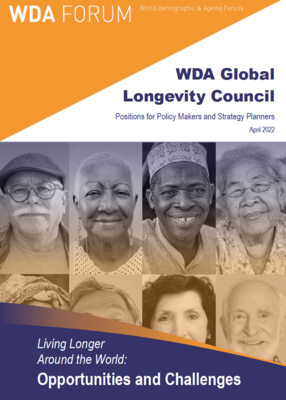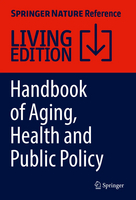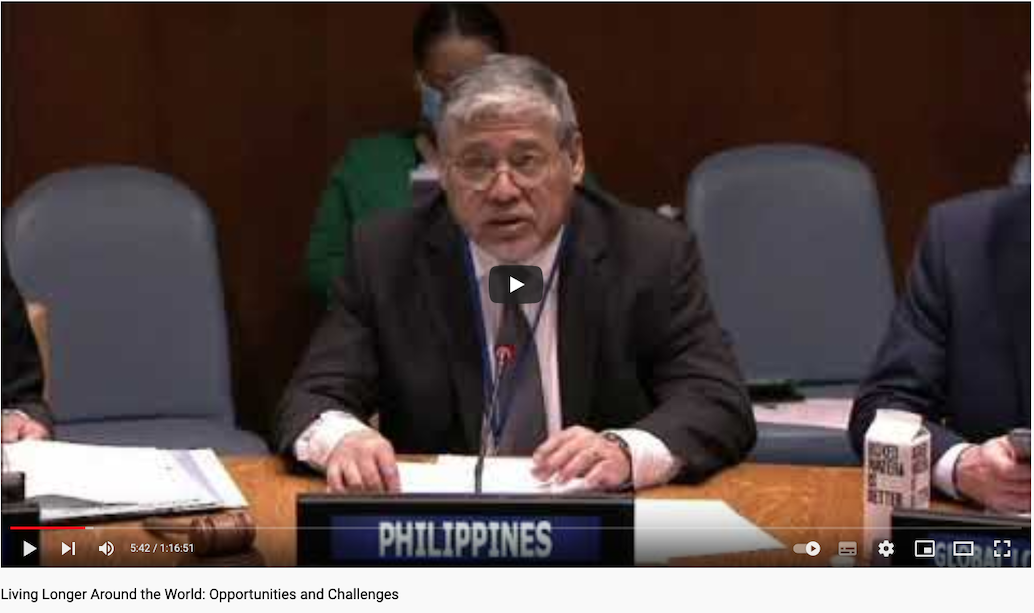Vision & Purpose of the Global Longevity Council

The Council has a global view on demography and related other megatrends with a time horizon until 2050:
- To guide business, society and policy makers successfully through on-going population dynamics, longevity and interdependencies with other global megatrends.
- To identify new ways of doing business and thus capture untapped opportunities in a world of demographic change.
- To serve as a global discussion platform for strategy and planning efforts guided by demography.

«Living Longer Around the World: Opportunities and Challenges»
WDA Global Longevity - 1st Paper - April 2022
Positions for Policy Makers and Strategy Planners
In April 2022, Global Coalition on Aging (GCOA), in partnership with the Permanent Missions of Chile and the Republic of the Philippines, United Nations Department of Economic and Social Affairs (UNDESA), and the World Demographic & Ageing Forum (WDA Forum) Global Longevity Council, hosted an official side event of the 55th Session of the Commission on Population and Development at the United nations in New York to launch "Living Longer Around the World: Opportunities and Challenges", a new report authored by the WDA Forum Global Longevity Council. The report offers positions for policy makers and strategy planners based on age demographics to 2035 for 31 countries representing all levels of economic development 70% of the global population, and 76% of global GDP.
The speakers from around the world included:
- Chargé d'Affaires a.i., René Ruidiaz, Permanent Mission of Chile and Chair of the Group of Friends of Older Persons in New York
- H.E. Mrs. Francisca Perales, Vice Minister of Social Services, Ministry of Social Development and Family of Chile
- H.E. Ambassador Bostjan Malovrh, Permanent Representative of Slovenia to the United Nations
- Dr. Hans Groth, Chair of the World Demographic & Ageing Forum (WDA)
- Dr. Pol Vandenbroucke, Chair of the WDA Forum Global Longevity Council
- Dr. Yosuke Kita, Counselor, Permanent Mission of Japan to the United Nations
- Ms. Bernardita Canals, Consultant at National Service for the Elderly Adults (SENAMA), Government of Chile
- Dr. Karoline Schmid, Chief, Fertility and Population Ageing Section, Department of Economic and Social Affairs, Population Division
- Dr. Nicholas Eberstadt, Henry Wendt Chair for Political Economy, American Enterprise Institute, Member WDA Global Longevity Council
- Dr. Gloria Langat, Aging and Development Unit, African Population and Health Research Centre, Kenya, Member WDA Global Longevity Council
Key Literature on Ageing & Longevity
World Population Ageing 2019 - Highlights
United Nations - Department of Economic and Social Affairs
Years of good life is a well-being indicator designed to serve research on sustainability
Wolfgang Lutz, Erich Striessnig, Anna Dimitrova, Simone Ghislandi, Anastasia Lijadi, Claudia Reiter, Sonja Spitzer and Dilek Yildiz
Expert Forum on Demographic Transitions: Impact on Longevity,
Health and Economy
January 27, 2023

Handbook of Aging, Health and Public Policy
Springer - February 23, 2023
Martin Dahinden & Hans Groth
«Mitigation and Adaptation: Analyzing and Shaping Demographic Change»
Demography, the statistical study of human populations, has rapidly gained importance in recent political discussions, both in individual countries and multilateral institutions. Demographic data are an excellent starting point for policymaking because they allow for long-term and reliable projections. However, in most cases, demographic issues are addressed in a rather selective manner with a focus on individual topics such as pension systems, migration, or workforce development. A comprehensive view is rather rare. The lack of a holistic view and comprehensive policy approaches entail the risk of acting too late and inadequately to problems brought about by the consequences of demographic changes. The concept of mitigation and adaptation, developed and successfully applied in other fields, has great potential when applied to demographic issues. The concept does not explain demographic change, nor is it a generator of solutions. However, it can form a useful framework and heuristic approach for understanding demographic change, classifying challenges, and deriving measures and policies. Precisely because the concept is not a closed model, it invites the consideration of research findings from very different fields.


